9K32 Strela-2
The 9K32 Strela-2 (Russian: Cтрела, "arrow"; NATO reporting name SA-7 Grail) is a light-weight, shoulder-fired, surface-to-air missile (or MANPADS) system. It is designed to target aircraft at low altitudes, with passive infrared homing guidance and destroy them with a high explosive warhead.
| 9K32 Strela-2 SA-7 Grail | |
|---|---|
 KBM Kolomna 9K32M Strela-2M (SA-7b) missile and canister | |
| Type | Man portable surface-to-air missile launcher |
| Place of origin | Soviet Union |
| Service history | |
| In service | 1968[1]–present |
| Used by | See operators |
| Wars | War of Attrition Yom Kippur War Portuguese Colonial War Vietnam War Cambodian Civil War The Troubles Western Sahara War Rhodesian Bush War Nicaraguan Revolution Salvadoran Civil War 1982 Lebanon War Lebanese Civil War Iran–Iraq War Gulf War Falklands War Second Sudanese Civil War South African Border War Soviet–Afghan War War in Afghanistan Syrian occupation of Lebanon Yugoslav Wars Iraq War Libyan Civil War (2011) Insurgency in Egypt (2013–present) (Sinai insurgency) Syrian Civil War War in Donbass Yemeni Civil War (2015–present) Libyan Civil War (2014–present) |
| Production history | |
| Designer | KBM (Kolomna) |
| Designed | c. 1964 |
| Unit cost | US$120,000 (launcher with 5 missiles, export price to Libya, 1972-1973)[2] |
| Variants | See versions |
| Specifications | |
| Mass | 9.8 kg (21.6 lb) (Strela-2M missile)[3] 15 kg (33.1 lb) (system, ready to fire)[3] |
| Length | 1.44 m[3] |
| Diameter | 72 mm[3] |
| Maximum firing range | 3,700 m (Strela-2) 4,200 m (Strela-2M)[3] |
| Warhead weight | 1.15 kg directed-energy blast fragmentation warhead (Strela-2M),[3] 370 g HE content |
Detonation mechanism | Non-delay impact and grazing fuzes, 14–17 second delay self-destruct. |
| Wingspan | 0.3 m |
| Flight altitude | 50–1500 m (Strela-2) 50–2300 m (Strela-2M)[3] |
| Maximum speed | 430 m/s (Strela-2) 500 m/s (Strela-2M)[4] |
Guidance system | Proportional navigation logic |
Broadly comparable in performance with the US Army FIM-43 Redeye, the Strela-2 was the first Soviet man-portable SAM – it entered use in 1968,[5] and full-scale production began in 1970.[6] While the Redeye and 9K32 Strela-2 were similar, the missiles weren’t identical. Nonetheless, the CIA concluded that the Soviet SA-7 had benefited from the Redeye’s development.[7]
The Strela-2 was a staple of the Cold War and was produced in huge numbers for the Soviet Union and their allies, as well as revolutionary movements.[8] Though since surpassed by more modern systems, the Strela and its variants remain in service in many countries, and have seen widespread use in nearly every regional conflict since 1972.
Development
The end of World War II saw a major shift in Soviet defense policy. The advent of long range, high altitude, nuclear-armed American bombers, capable of penetrating Soviet airspace at heights and speeds unreachable and unmatchable by anti-aircraft guns and most interceptors, appeared to render every conventional weapon obsolete at a stroke. Numerous long-range, high-altitude SAM systems, such as the SA-1 "Guild" and SA-2 "Guideline", were rapidly developed and fielded to counter this large vulnerability. Due to the apparent "obsolescence" of conventional arms, however, relatively little development took place to field mobile battlefield air defenses.
This direction was soon changed with the beginning of the Korean War. An entirely conventional conflict, it proved that nuclear weapons were not the be-all and end-all of warfare. In the face of a powerful and modern American air force, carrying non-nuclear payloads, the Soviet Union invested heavily in a multi-tier air defense system, consisting of several new mobile SAMs, to cover all altitude ranges and protect ground forces. The new doctrine listed five requirements:
- Front-level medium-to-high-altitude area defense system 9K8 Krug (NATO designation SA-4 "Ganef")
- Army-level low-to-medium-range area defense system 3K9 Kub (NATO designation SA-6 "Gainful")
- Division-level low-altitude short-range system 9K33 Osa (NATO designation SA-8 "Gecko")
- Regiment-level all-weather radar-guided gun system ZSU-23-4 "Shilka" and very-short-range missile systems Strela-1 (NATO designation SA-9 "Gaskin")
- Battalion-level man-portable Strela-2 (NATO SA-7 "Grail")
Both Strela-1 and Strela-2 were initially intended to be man-portable systems. As the Strela-2 proved to be a considerably smaller and lighter package, however, the role of the Strela-1 was changed, becoming a heavier, vehicle-mounted system with increased range and performance to better support the ZSU-23-4 in the regimental air defense role.

As development began in the Turopov OKB (later changed to Kolomna), detailed information on the design of the US FIM-43 Redeye became available. While it was by no means a simple reverse-engineered copy, in many ways the Strela design borrowed heavily from the Redeye, which had started development a few years earlier. Due to the comparatively primitive Soviet technical base, development was protracted, and many problems arose, especially in designing a sufficiently small seeker head and rocket. Eventually, the designers settled for a simpler seeker head than that of the Redeye, allowing the initial version, the 9K32 "Strela-2" (US DoD designation SA-7A, missile round 9M32) to finally enter service in 1968, five years behind schedule. At the time, it was described by one expert as being "the premier Russian export line".[9]
Improvements
The initial variant suffered from numerous shortcomings: it could only engage targets flying at relatively slow airspeeds and low altitudes and then only from rear hemisphere, it suffered from poor guidance reliability (particularly in the presence of natural or man-made background IR radiation sources), and even when a hit was achieved, it often failed to destroy the target.[10][11] Poor lethality was an issue especially when used against jet aircraft: the hottest part of the target was the nozzle behind the actual engine, which the missile therefore usually hit – but there its small warhead often failed to cause significant damage to the engine itself.
In order to address the shortcomings, two improved versions were ordered in 1968; as an intermediate stop-gap the slightly improved 9K32M "Strela-2M" (NATO reporting name SA-7b) to replace the original, as well as the more ambitious Strela-3.

As the modifications introduced with the Strela-2M were relatively minor, the process was fast and it was accepted in service in 1970.[11] The Strela-2M replaced the Strela-2 in production lines immediately. Improvements were made particularly to increase the engagement envelope of the new system:[10]
- Higher thrust propellant increased slant range from 3.4 to 4.2 km (2.1 to 2.6 mi) and ceiling from 1.5 to 2.3 km (0.93 to 1.43 mi)
- Improved guidance and control logic allowed the engagement of helicopters and propeller-driven aircraft (but not jets) approaching at a maximum speed of 150 m/s (490 ft/s; 340 mph)
- Maximum speed of receding targets was increased from 220 to 260 m/s (720 to 850 ft/s; 490 to 580 mph)
- More automated gripstock provided a simplified firing method against fast targets: a single trigger pull followed by lead and superelevation replacing the separate stages of releasing the seeker to track, and launching the missile (see description below)
Contrary to what was at first reported in some Western publications, more recent information indicates that, while lethality on impact had proven to be a problem, the warhead remained the same 1.17 kg (2.6 lb) unit (including 370-gram (13 oz) TNT charge) as in the original.[12] This remained the warhead of all Soviet MANPADS up to and including most 9K38 Igla variants; to address the problem of poor lethality, a more powerful HE filling than TNT, improved fuzing, a terminal maneuver, and finally a separate charge to set off any remaining rocket fuel were gradually introduced in later MANPADS systems, but the original Strela-2/2M warhead design of a 370-gram (13 oz) directed-energy HE charge in a pre-fragmented casing remained.
The seeker head improvements were only minor changes to allow better discrimination of the target signal against background emissions.[10][12] Some sources claim that the seeker sensitivity was also improved.[11] The only defence against infra-red countermeasures remained the seeker head's narrow field of view, which could be hoped to help the rapidly slowing flare fall off the missile field of view as it was tracking a fast-moving target.[10] In practice, flares proved to be a highly effective countermeasure against both versions of the Strela-2.
The seeker is commonly referred to as a hot metal tracker. The seeker can only see infrared energy in the near infrared (NIR) spectrum, emitted by very hot surfaces only seen on the inside of the jet nozzle. This allows only rear-aspect engagement of jet targets, earning the weapon its other moniker as a revenge weapon, since the missile has to "chase" an aircraft after it has already passed by.
The Strela-2M was also procured for use on-board Warsaw Pact warships;[13] installed on four-round pedestal mounts[13] aboard Soviet amphibious warfare vessels and various smaller combatants, the weapon remained unchanged, but was assigned the NATO reporting name SA-N-5 "Grail".[13]
Description
The missile launcher system consists of the green missile launch tube containing the missile, a grip stock and a cylindrical thermal battery. The launch tube is reloadable at depot, but missile rounds are delivered to fire units in their launch tubes. The device can be reloaded up to five times.[14]

When engaging slow or straight-receding targets, the operator tracks the target with the iron sights in the launch tube and applies half-trigger. This action "uncages" the seeker and allows its attempt to track. If a target IR signature can be tracked against the background present, this is indicated by a light and a buzzer sound. The shooter then pulls the trigger fully, and immediately applies lead and superelevation. This method is called a manual engagement. An automatic mode, which is used against fast targets, allows the shooter to fully depress the trigger in one pull followed by immediate lead and superelevation of the launch tube. The seeker will uncage and will automatically launch the missile if a strong enough signal is detected.
The manufacturer lists reaction time measured from the carrying position (missile carried on a soldier's back with protective covers) to missile launch to be 13 seconds, a figure that is achievable but requires considerable training and skill in missile handling. With the launcher on the shoulder, covers removed and sights extended, reaction time from fire command to launch reduces to 6–10 seconds, depending greatly on the target difficulty and the shooter's skill.
After activating the power supply to the missile electronics, the gunner waits for electricity supply and gyros to stabilize, puts the sights on target and tracks it smoothly with the launch tube's iron sights, and pulls the trigger on the grip stock. This activates the seeker electronics and the missile attempts to lock onto the target. If the target is producing a strong enough signal and the angular tracking rate is within acceptable launch parameters, the missile alerts the gunner that the target is locked on by illuminating a light in the sight mechanism, and producing a constant buzzing noise. The operator then has 0.8 seconds to provide lead to the target while the missile's on-board power supply is activated and the throw-out motor ignited.
Should the target be outside acceptable parameters, then the light cue in the sight and the buzzer signal tell the gunner to re-aim the missile.
On launch, the booster burns out before the missile leaves the launch tube at 32 m/s and rotating at around 20 revolutions per second. As the missile leaves the tube, the two forward steering fins unfold, as do the four rear stabilizing tail fins. The self-destruct mechanism is then armed, which is set to destroy the missile after between 14 and 17 seconds to prevent it hitting the ground if it should miss the target.

Once the missile is five and a half meters away from the gunner, c. 0.3 seconds after leaving the launch tube, it activates the rocket sustainer motor. The sustainer motor takes it to a velocity of 430 metres per second (1,400 ft/s; 960 mph), and sustains it at this speed. Once it reaches peak speed, at a distance of around 120 metres (390 ft) from the gunner, the final safety mechanism is disabled and the missile is fully armed. All told, the booster burns for 0.5 second and the driving engine for another 2.0 seconds.[14]
The missile's uncooled lead sulfide passive infra-red seeker head detects infrared radiation at below 2.8 μm in wavelength. It has a 1.9 degree field of view and can track at 9 degrees per second. The seeker head tracks the target with an amplitude-modulated spinning reticle (spin-scan or AM tracking), which attempts to keep the seeker constantly pointed towards the target. The spinning reticle measures the amount of incoming infrared (IR) energy. It does this by using a circular pattern that has solid portions and slats that allow the IR energy to pass through to the seeker. As the reticle spins IR energy passes through the open portions of the reticle. Based on where the IR energy falls on the reticle the amount or amplitude of IR energy allowed through to the seeker increases the closer to the center of the reticle. Therefore, the seeker is able to identify where the center of the IR energy is. If the seeker detects a decrease in the amplitude of the IR energy it steers the missile back towards where the IR energy was the strongest. The seeker's design creates a dead-space in the middle of the reticle. The center mounted reticle has no detection capability. This means that as the seeker tracks a target as soon as the seeker is dead center, (aimed directly at the IR source) there is a decrease in the amplitude of IR energy. The seeker interprets this decrease as being off target so it changes direction. This causes the missile to move off target until another decrease in IR energy is detected and the process repeats itself. This gives the missile a very noticeable wobble in flight as the seeker bounces in and out from the dead-space. This wobble becomes more pronounced as the missile closes on the target as the IR energy fills a greater portion of the reticle. These continuous course corrections effectively bleed energy from the missile reducing its range and velocity.
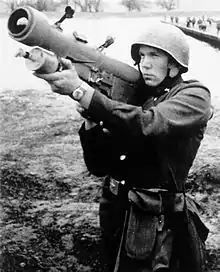
The guidance of the SA-7 follows proportional convergence logic, also known as angle rate tracking system or pro-logic. In this method, as the seeker tracks the target, the missile is turned towards where the seeker is turning towards – not where it is pointing at – relative to the missile's longitudinal axis. Against a target flying in a straight-line course at constant speed, the angle rate of seeker-to-body reduces to zero when the missile is in a straight-line flight path to intercept point.
Combat use
As a consequence of their widespread availability and large numbers, the Strela system has seen use in conflicts across the globe.
Egypt
The first combat use of the missile is credited as being in 1969 during the War of Attrition by Egyptian soldiers.[15] The first "kill" was claimed on 19 August 1969. An Israeli 102 Squadron A-4H Skyhawk was hit with a shoulder-fired missile 12 miles west of the Suez Canal and pilot SqL Nassim Ezer Ashkenazi captured. Between this first firing and June 1970 the Egyptian army fired 99 missiles resulting in 36 hits. The missile proved to have poor kinematic reach against combat jets, and also poor lethality as many aircraft that were hit managed to return safely to base.
The missile was used later in the Yom Kippur War,[16][17] where 4356 Strelas were fired,[16] scoring few hits and fewer kills (2[17]–4[16]), with 26[17]–28[16] damaged. (A-4s had their exhaust pipes lengthened, in order to prevent fatal damage to the engine, a solution made in the previous war, together with flare launchers) but, together with Shilka and SA-2/3/6s, they caused very heavy losses to the Israeli Air Force in the first days, after that the Arab SAMs firings were so high, that they almost depleted their weapon stocks. SA-7s were not that effective against fast jets, but they were the best weapon available to Arab infantry at the time.
A Strela 2 was reportedly used by the Islamist militant group Ansar Bait al-Maqdis to destroy an Egyptian military Mil-8 helicopter operating in the northern Sinai region on 26 January 2014 near Sheikh Zuweid (close to the border with Gaza), killing its five occupants. This is the first attack of this type during the Sinai insurgency, which has raged on the peninsula due to the security and political turmoil since the 2011 revolution. The MANPADS is reported by United Nations to have come from former Libyan leader Muammar Gaddafi's large stocks, which have been widely proliferated after Libya's civil war chaos and have become a concern to regional and world security.[18][19]
Syria
The Strela was deployed by Syrian forces occupying Lebanon, along with other Soviet air-defence systems that challenged U.S., French and Israeli airpower in the aftermath of the 1982 conflict and the deployment of the Multinational Force in Lebanon during that year. On 10 November 1983, a French Super Etendard escaped from being hit by an SA-7 near Bourj el-Barajneh while flying over Druze People’s Liberation Army (PLA) positions and, on 3 December, more Strelas and anti-aircraft artillery (AAA) were fired at United States Navy F-14 Tomcats flying a reconnaissance mission.[20][21]
The Americans responded with a large strike package of 12 A-7 Corsairs and 16 A-6 Intruders (supported by a single E-2C Hawkeye, two EA-6B Prowlers and two F-14As) launched from the carriers USS John F. Kennedy (CV-67) and USS Independence (CV-62) sailing in the Mediterranean. The aircraft were to bomb Syrian installations, AAA sites and weapons depots near Falouga and Hammana, some 16 km north of Beirut-Damascus highway, when they were received by a volley of (possibly up to 40) Syrian SAMs, one of which hit a Corsair (AE305 of the VA-15) and forcing the pilot to eject over the sea before being rescued by a USN search and rescue mission.[21]
The attack formation broke, every pilot attacked each objective on its own and it prompted the shooting down of the second U.S aircraft: an Intruder from VA-85 was hit either by an SA-7 or an SA-9. This forced the navigator, Lieutenant Bobby Goodman to eject near a village surrounded by Syrian positions, while the pilot of the A-6, Lt. Mark Lange, ejected too late and died from his wounds soon after being captured by Syrian soldiers and Lebanese civilians. Goodman was captured by the Syrians and taken to Damascus before being freed in January 1984.[20][22]
A second Corsair, searching for the downed Intruder crew, was later hit by an SA-7 but the pilot, Cdr. Edward Andrews, managed to eject over the sea near Beirut and was rescued by a fisherman and his son who in turn handed him over to the U.S Marines.[20][22]
During the current civil war, several Strelas have made their way to rebel hands and their firings have been uploaded to YouTube. In 2013, Foreign Policy, citing rebels sources, reported the shipment, with Qatari help, of some 120 SA-7s from Libya (with large stocks acquired by Gaddafi and proliferated after that country's civil war) through Turkey and with Turkish authorities' knowledge[19][23][24]
Lebanon
On 24 June 1974, Palestinian guerrillas operating in southern Lebanon fired two SA-7s against invading Israel Air Force (IAF) aircraft, though no hits were scored.[25]
During the 1983–84 Mountain War, the Druze People's Liberation Army (PLA) militia received from Syria a number of Strela missiles, which were used to bring down two Lebanese Air Force Hawker Hunter fighter jets[26] and one Israeli IAI Kfir fighter-bomber aircraft, on November 20, over the mountainous Chouf district southeast of Beirut (the pilot was rescued by the Lebanese Army).[27][28][29] The Christian Maronite Lebanese Forces militia (LF) also received from Iraq a number of Strela missiles in 1988–89.[30]
The Shiite Hezbollah guerrilla group also acquired some Strelas in the late 1980s and fired them against Israeli aircraft in November 1991.[31] Since then, they have since fired many Strelas against Israeli aircraft, including two against Israeli warplanes on 12 June 2001 near Tyre, but have never scored a hit.[32]
Iraq
In the early dawn of 31 January 1991, during the Battle of Khafji in Operation Desert Storm, an Iraqi soldier shot down an American AC-130H gunship with a Strela 2, killing all 14 crewmembers.[33]
Strela-2 missiles have been used against Turkish Army helicopters by the PKK in northern Iraq. During Operation Hammer; on 18 May 1997, a Strela-2 missile was used to shoot down an AH-1W Super Cobra attack helicopter. Only a couple of weeks later, on 4 June 1997, another Strela was used to bring down a Turkish Army AS-532UL Cougar transport helicopter in the Zakho area, killing the 11 soldiers on board.[34][35][36] The video of the first attack was used extensively for PKK propaganda and eventually released to the Internet. Greece and Serbia's intelligence services, as well as Iran, Syria, Armenia, and Cyprus were traced as possible sources of the missiles.[34][37]
A Strela-2 missile is said to have been used in April 2005, when members of the insurgents shot down an Mi-8 helicopter operated by Blackwater, killing all 11 crew members. The Islamic Army in Iraq took responsibility for the action and a video showing the downing was released on the Internet.[38] The missile launcher is not visible on the video, however, making it impossible to confirm the type of MANPADS used.
The spate of helicopter shoot downs during 2006 and 2007 in Iraq has been partly attributed to the prevalence of the Strela amongst Sunni insurgent groups of that time;[39] while al Qaeda is said to have produced an hour-long training video on how to use SA-7s.[32]
Saudi Arabia
In late 2001, a Sudanese man with links to Al-Qaida fired an SA-7 at an American F-15 Eagle fighter taking off from Prince Sultan Air Base in Saudi Arabia. The missile missed the target and was not detected by the pilot or anyone at the base. Saudi police found the empty launcher in the desert in May 2002, and a suspect was arrested in Sudan a month later. He led police to a cache in the desert where a second missile was buried.[40]
Gaza
During October 2012, militants in Gaza fired a Strela in an attempt to down an IDF helicopter.[41] During Operation Pillar of Defense, Hamas released a video purporting to be a launch of Strela missile at an IAF target.[42] One was also reportedly fired in March 2013 from Gaza at an IAF helicopter.[41]
Yemen
Al-Qaeda in the Arabian Peninsula allegedly shot down a UAE Mirage fighter jet with a Strela during the Yemeni Civil War (2015–present).[43] Houthi rebels were seen carrying 9K32 Strela-2s.[44]
Southeast Asia
The Strela-2 system was also given to North Vietnam, where along with the more advanced Strela-2M it achieved 204 hits out of 589 firings against US and South Vietnamese aircraft between 1972 and 1975 according to Russian sources.[12] (Some sources, such as Fiszer (2004),[11] claim that it had already been in use from 1968 onwards).
A total of c. 70–80 kills are attributed to Strela-2/2M hits between 1971 and the Fall of Saigon in April 1975, almost all against helicopters and propeller-driven aircraft. As in the War of Attrition, the missile's speed and range proved insufficient against fast jets and results were very poor: only one US A-4 Skyhawk and one South Vietnamese F-5 Freedom Fighter are known to have been shot down by with Strela-2s during the conflict.
U.S fixed-wing losses are listed in the following table.[45] The internet site Arms-expo.ru[12] states 14 fixed-wing aircraft and 10 helicopters were shot down with 161 missile rounds used between 28 April and 14 July 1972; the difference in fixed-wing losses may be at least partly due to South Vietnamese aircraft shot down by the weapon.
| Date | Type | Unit | Altitude when hit | Casualties | Mission | Location | |
|---|---|---|---|---|---|---|---|
| ft | m | ||||||
| 1972-05-01 | O-2A | 20th TASS | 0 | FAC | Quang Tri | ||
| 1972-05-01 | A-1H | 1 SOS | 3,500 | 1,100 | 0 | SAR | Quang Tri |
| 1972-05-02 | A-1E | 1 SOS | 5,500 | 1,700 | 0 | SAR | Quang Tri |
| 1972-05-02 | A-1G | 1 SOS | 6,500 | 2,000 | 1 WIA | SAR | Quang Tri |
| 1972-05-14 | O-1 | 4,000 | 1,200 | 0 | FAC | An Loc | |
| 1972-05-26 | TA-4F | H&MS-15 | 4,500 | 1,400 | 0 | armed recce | Hue |
| 1972-06-15 | AC-130A | 16 SOS | 12 KIA | armed recce | A Shau | ||
| 1972-06-29 | OV-10A | 20 TASS | 6,500 | 2,000 | 1 KIA | FAC | Quang Tri |
| 1972-07-02 | O-1 | 0 | FAC | Phum Long (Cambodia) | |||
| 1972-12-19 | OV-10A | 20 TASS | 1 KIA | FAC | Quang Tri | ||
| 1973-01-27 | OV-10A | 23 TASS | 6,000 | 1,800 | 2 MIA | FAC | Quang Tri |
The table shows heavy losses particularly in the beginning of May, with especially lethal results on the 1st and 2nd, where the shootdown of the O-2 FAC led to further losses when a rescue operation was attempted. After these initial losses, changes in tactics and widespread introduction of decoy flares helped to counter the threat, but a steady flow of attrition and necessity of minimizing time spent in the Strela's engagement envelope nonetheless continued to limit the effectiveness of US battlefield air operations until the end of US involvement in South-East Asia. The United States lost at least 10 AH-1 Cobras and several UH-1 Hueys to Strela-2/2M hits in South East Asia.
From January 1973 to June 1974, the Republic of Vietnam Air Force lost 17 aircraft and helicopter by Strela-2[46]
In the late 1980s, Strela-2s were used against Royal Thai Air Force aircraft by Laotian and Vietnamese forces during the numerous border clashes of that period. An RTAF F-5E was damaged on 4 March 1987 and another F-5E was shot down on 4 February 1988 near the Thai-Cambodian border.
Afghanistan
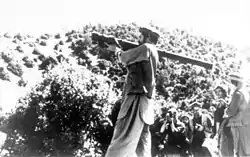
Strela-2M was used also in Afghanistan during the Soviet–Afghan War by the Mujahiddeen. The missiles were obtained from various sources, some from Egypt and China (locally manufactured Sakr Eye and HN-5 versions of the SAM), and the CIA also assisted the guerrillas in finding missiles from other sources.
Results from combat use were not dissimilar from experiences with the Strela-2/2M from Vietnam: while 42 helicopters were shot down by various Strela-2 variants (including a few Mi-24s until exhaust shrouds made them next to invisible to the short-wavelength Strela-2 seeker) only five fixed-wing aircraft were destroyed with the weapon. Due to its poor kinematic performance and vulnerability to even the most primitive infra-red countermeasures, the guerrillas considered the Strela-2 suitable for use against helicopters and prop-driven transports, but not combat jets.
However, the recent studies and interviews after the Cold war say that most Strelas sold to the Mujahiddeen on the black market were broken/damaged or faulty. This is possibly another reason why the Soviet army in Afghanistan didn't expect working anti-aircraft missiles like the Stinger to be used.[47]
On 22 July 2007 the first reported attack of the Taliban against a coalition aircraft using MANPADS was reported. The weapon was reported to be an SA-7 allegedly smuggled from Iran to the Taliban. The missile failed after the crew of the USAF C-130, flying over the Nimroz province, launched flares and made evasive manoeuvers.[48]
However, most of the Strelas operated by al-Qaeda in Afghanistan are probably inherited from fighters that used it during the Soviet invasion. Most are probably faulty, broken or in other ways not usable (even from the beginning) against military helicopters, with the intercepts of NATO aviation by Stingers (acquired also during 80s) or other missiles.
Guinea-Bissau
When PAIGC rebels in Guinea began to receive SA-7s in early 1973, these immediately became a threat to Portuguese air superiority. On 23 March 1973, two Portuguese Air Force (FAP) Fiat G.91s were shot down by SA-7s, followed six weeks later by another Fiat, and a Dornier Do 27.[49]
Mozambique
FRELIMO fighters in Mozambique were also able to field some SA-7s with Chinese support, although the weapon is not known to have caused any losses to the FAP, even if it forced Portuguese pilots to change their tactics. In one case a Douglas DC-3 carrying foreign military attaches and members of the senior Portuguese military command was hit by an SA-7 in one of the engines. The crippled plane managed to land safely and was later repaired.[50]
Angola
In Angola and Namibia, SA-7s were deployed against the South African Air Force with limited success. The SAAF lost Atlas Impalas to Strelas on 24 January 1980 and 10 October 1980. Another Impala was hit by an SA-7 on 23 December 1983, but the pilot was able to fly the aircraft back to Ondangwa AB.[51] UNITA also reportedly obtained 50 SA-7s that Israel had captured, via the CIA. The first one was fired at Cuban aircraft by a French mercenary on 13 March 1976, but the missile failed to hit the target. The individual missiles may have been in poor condition, as none scored a direct hit.[52] Additionally, it is claimed that UNITA used SA-7s to shoot down two Transafrik International Lockheed L-100-30 Hercules flying UN charters, on 26 December 1998[53] and 2 January 1999,[54] both near Huambo.[55]
Sudan
Using an SA-7, the Sudan People's Liberation Army shot down a Sudan Airways Fokker F-27 Friendship 400M taking off from Malakal on 16 August 1986, killing all 60 on board.[56] On 21 December 1989, an Aviation Sans Frontières Britten-Norman BN-2A-9 Islander (F-OGSM) was shot down by an SA-7 while taking off from Aweil Sudan, killing the four crew on board.[57]
Western Sahara
The Polisario Front has used SA-7s against the Royal Moroccan Air Force and Mauritanian Air Force during the Western Sahara War over the former Spanish colonies of the Spanish Sahara. The Mauritania Air Force lost a Britten-Norman Defender to a SA-7 fired by the Polisario on 29 December 1976.[58] Between 1975 and 1991, the Royal Moroccan Air Force has lost several Northrop F-5A Freedom Fighters and Dassault Mirage F1s to SA-7s fired by the Polisario.[59] In a case of mistaken identity, a Dornier 228 owned by the Alfred Wegener Institute for Polar and Marine Research was shot down over the Western Sahara near Dakhla on 24 February 1985. Two Dornier 228s named Polar 2 and Polar 3 were on a return flight to Germany following a South Pole expedition. After having taken off from Dakar, Senegal, en route to Arrecife, Canary Islands, flying 5 minutes behind Polar 2 and at a lower altitude (9,000 feet), Polar 3 was shot down by a SA-7 fired by the Polisario.[60] The crew of three was killed. In another incident, on 8 December 1988, two Douglas DC-7CFs flying at 11,000 feet from Dakar, Senegal to Agadir, Morocco for a locust control mission there, had SA-7s fired at them by the Polisario. One aircraft, N284, was hit and lost one of its engines and part of a wing. This led to the aircraft crashing, killing the crew of five.[61] The other aircraft, N90804, also was hit and lost an engine along with suffering other damage, but it was able to land safely at Sidi Ifni Morocco.[62]
Airliner attacks
During the Rhodesian Bush War, members of the military wing of the Zimbabwe People's Revolutionary Army brought down two Vickers Viscount civilian airliners near Kariba; the first in September 1978, the second in February 1979. There was great loss of life in both instances as the flights were returning from a well known tourist attraction.[63]
- Vickers Viscount, Flight RH825, 3 September 1978 – downed by a Strela missile near Kariba Dam. After initial impact, the pilot was able to make an emergency landing in a nearby field but the aircraft broke up on impact. Eighteen of the fifty-six passengers in the tail section survived the crash. Ten of these survivors were shot dead at the crash-site by insurgents, who later looted the bodies and wreckage.[63]
- Vickers Viscount, Flight RH827, 12 February 1979 – shot by down Strela missile near Kariba Dam; all 59 people on board were killed.
UNITA claimed that they used one to shoot down a TAAG Boeing 737-2M2 taking off from Lubango on 8 November 1983.[64]
A Lignes Aériennes Congolaises Boeing 727-30 taking off from Kindu was shot down by an SA-7 fired by rebel forces in 1998, killing all 41 on board.[65]
Two missiles were fired at a Boeing 757 during the 2002 Mombasa attacks in Kenya. Neither missile struck its target.[66][67]
Argentina
Strela-2M missiles were available to Argentinian troops in the Falkland Islands during the Falklands War. War Machine Encyclopedia gives no launch recorded, but several missiles were captured.[68] The missiles were supplied by Libya.[69]
Nicaragua
The Strela-2 was used by both Sandinista government forces and Contra insurgents during the 1979–1990 civil war.
On 3 October 1983, at about 10:00 am, a Contra-operated Douglas DC-3 carrying supplies, that had taken off from Catamacas airport in Honduras, was hit and downed by a Strela fired by Sandinista soldier Fausto Palacios over the area of Los Cedros, in the Nueva Segovia Department. Four crewmen were captured by government forces while one died in the crash. The pilot, Major Roberto Amador Alvarez, as well as his co-pilot Capt. Hugo Reinaldo Aguilar were former members of the extinct National Guard of the former dictator Anastasio Somoza Debayle.[70][71][72]
On 27 August 1984, a Contra-operated Douglas C-47 Skytrain was hit and downed by another Strela fired by Sandinista soldier Fanor Medina Leyton. Sources differ over the attack and crash area: both a Russian source and Sandinista officials reported the Jinotega Department, while the Aviation Safety Network reports the Quilalí area in the Nueva Segovia department. All eight occupants were killed. The pilot, José Luis Gutiérrez Lugo, was reported as a former pilot for the Somoza family. Sandinista and Contra forces subsequently battled for the control of six packages dropped from the plane.[70][73][74]
On 5 October 1986 a Corporate Air Services C-123 Provider (HPF821, previously N4410F and USAF 54-679, (c/n 20128))[75] conducting a covert drop of arms to Contra fighters in Nicaragua was shot down by Sandinista soldier José Fernando Canales Alemán, using an SA-7. CIA pilots William J. Cooper and Wallace "Buzz" Sawyer as well as radio operator Freddy Vilches were killed in the crash. Loadmaster Eugene Hasenfus parachuted to safety and was taken prisoner. He was later released in December 1986.[76] The flight had departed Ilopango Airport, El Salvador loaded with 70 Soviet-made AK-47 rifles and 100,000 rounds of ammunition, rocket grenades and other supplies.[77]
El Salvador
FMLN rebels acquired SA-7 missiles around 1989 and employed them extensively in the closing years of the Salvadoran Civil War, dramatically increasing the combat losses of Salvadoran Air Force aircraft. At least two O-2 Skymasters (on 26 September and 19 November 1990), one A-37 Dragonfly (on November 23, 1990), two Hughes 500 helicopters (2 February and 18 May 1990), and two UH-1Hs were lost to SA-7s. One of the UH-1Hs (on 2 January 1991) was crewed by US Army personnel, while the other was operated by the Honduran Air Force.[78][79]
Colombia
In late December 2012, a video showing FARC rebels attempting to shoot down a Colombian Air Force Arpía helicopter with an SA-7 in the Cauca raised the alarm in the Colombian military, though the missile failed.[80] [81]
During that same month, a Strela was captured by the Colombian military. It is believed that they might came from Cuba, Nicaragua or Peru; the only Latin American operators of the type.[82] Furthermore, the CIA's motive to remove and destroy Chinese copies of the SA-7 (HN-5s) from Bolivia in 2005 was the fear of them reaching FARC rebels because, according to a US military magazine, “they used the HN-5 against Colombian-operated U.S-made helicopters”.[83] The Ecuadorian Army captured an HN-5 allegedly destined for the FARC in the border province of Sucumbíos, near Colombia, in July 2013.[84][85]
Georgia
SA-7 saw large usage by all sides during Georgian Civil War, First known loss to SA-7 happened on 13 June 1993, when GAF Su-25 was shot down by Strela over Shubara, on the second and third occasions, Georgian Civil aircraft, Tu-134A and Tu-134B were shot down by SA-7, Killing 110 people.[86]
Northern Ireland
The Provisional Irish Republican Army (IRA) acquired some missiles from Libya. One was reported to have been fired at a British Army Air Corps Lynx helicopter in July 1991 in South Armagh; however, it missed its target.[87] To counter the new threat, the British helicopters flew in pairs below 15 meters (50 feet) or above 150 meters (500 feet).
Spain
In 2001, the Basque separatist group ETA tried on three occasions (29 April, 4 and 11 May) to use Strela 2 missiles to shoot down the Dassault Falcon 900 aircraft with the then-Spanish Prime Minister Jose Maria Aznar on board. The attempts, which were made near the Fuenterrabía and Foronda airports, were unsuccessful as each time the missiles failed to launch. In 2004, several systems were captured by the Civil Guard.[88] Some Strela 2 missiles were bought from the IRA in 1999, while Libya was tracked as the original source used by the IRA.[89]
Versions

- 9K32M Strela-2M: "SA-7b Grail"
- Strela 2M/A: Yugoslav upgraded version with larger warhead
- CA-94 and CA-94M: Romanian license-built versions of the SA-7a and SA-7b, respectively
- HN-5: Chinese unlicensed copy
- Anza Mk-I: Pakistani license-built copy of Chinese HN-5
- Ayn al Saqr (عين الصقر; "Hawk Eye"): Egyptian copy[90]
- Hwasung-Chong: North Korean license-built copy of Egyptian Ayn al Saqr system[8]
- HT-16PGJ: North Korean unlicensed copy
Operators
Current operators
 Al-Nasser Salah al-Deen Brigades[91]
Al-Nasser Salah al-Deen Brigades[91] Al-Qaeda in the Arabian Peninsula[92]
Al-Qaeda in the Arabian Peninsula[92] al-Qaeda in the Islamic Maghreb[92]
al-Qaeda in the Islamic Maghreb[92] Al-Shabaab[93]
Al-Shabaab[93] Afghanistan[8]
Afghanistan[8] Algeria[94]
Algeria[94] Angola[94]
Angola[94] Armenia[8]
Armenia[8] Azerbaijan[94]
Azerbaijan[94]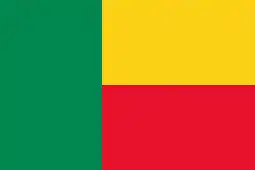 Benin[8]
Benin[8] Boko Haram[93]
Boko Haram[93] Bosnia and Herzegovina
Bosnia and Herzegovina Botswana[94]
Botswana[94] Bulgaria[94] license-built[8]
Bulgaria[94] license-built[8] Burkina Faso[94]
Burkina Faso[94] Burundi[94]
Burundi[94] Cambodia[95]
Cambodia[95] Cape Verde[8]
Cape Verde[8] Chad[8]
Chad[8] Cuba[94]
Cuba[94] Czech Republic[94]
Czech Republic[94] Democratic Forces for the Liberation of Rwanda: 2 systems[96]
Democratic Forces for the Liberation of Rwanda: 2 systems[96] Democratic Republic of the Congo[94]
Democratic Republic of the Congo[94] Ecuador[94]
Ecuador[94] Egypt[94]
Egypt[94] El Salvador[97]
El Salvador[97] Eritrea[94]
Eritrea[94] Ethiopia[94]
Ethiopia[94] Free Syrian Army[94]
Free Syrian Army[94] Georgia[94]
Georgia[94] Ghana[94]
Ghana[94] Guinea[94]
Guinea[94] Guinea-Bissau[94]
Guinea-Bissau[94] Guyana[95]
Guyana[95] Hamas[93]
Hamas[93] Hezbollah[93]
Hezbollah[93]- Hizbul Mujahideen[92]
 Houthis[44][98]
Houthis[44][98] India[94]
India[94] Iran[94]
Iran[94] Islamic State[92]
Islamic State[92] Islamic State Sinai Province[99]
Islamic State Sinai Province[99] Ivory Coast[94]
Ivory Coast[94]- Jaish al-Islam[100]
 Kazakhstan[8]
Kazakhstan[8] Kurdistan Workers' Party (PKK)[34][101]
Kurdistan Workers' Party (PKK)[34][101]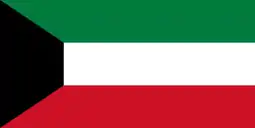 Kuwait[95]
Kuwait[95] Kyrgyzstan[94]
Kyrgyzstan[94] Laos[94]
Laos[94] Lebanon[94]
Lebanon[94] Libya[102]
Libya[102] Lord's Resistance Army[92]
Lord's Resistance Army[92] Mali[8]
Mali[8] Mauritania[94]
Mauritania[94]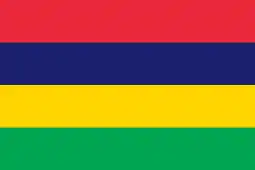 Mauritius[8]
Mauritius[8] Moldova[8]
Moldova[8] Mongolia[103][95]
Mongolia[103][95] Morocco[102]
Morocco[102] Movement for Oneness and Jihad in West Africa[93]
Movement for Oneness and Jihad in West Africa[93]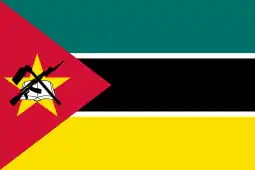 Mozambique[95]
Mozambique[95] Namibia[94]
Namibia[94]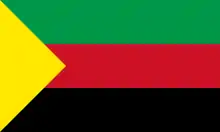 National Movement for the Liberation of Azawad[92]
National Movement for the Liberation of Azawad[92] Nicaragua[94]
Nicaragua[94] Nigeria[94]
Nigeria[94] North Korea[94]
North Korea[94] Oman[94]
Oman[94] Palestinian Islamic Jihad[92] (also known as al-Quds Brigades)
Palestinian Islamic Jihad[92] (also known as al-Quds Brigades) Peru[94]
Peru[94] Poland[94]
Poland[94] Popular Front for the Liberation of Palestine - General Command[94]
Popular Front for the Liberation of Palestine - General Command[94] Popular Mobilization Units[104]
Popular Mobilization Units[104] Qatar[94]
Qatar[94]- Rally of Democratic Forces[92]
 Romania[95]
Romania[95] Russia[94]
Russia[94] Rwanda[94]
Rwanda[94] Sahrawi Arab Democratic Republic
Sahrawi Arab Democratic Republic Serbia[94]
Serbia[94] Seychelles[95]
Seychelles[95] Sierra Leone[102]
Sierra Leone[102] Slovakia[94]
Slovakia[94] Somalia[95]
Somalia[95] Somaliland[92]
Somaliland[92] South Sudan[94]
South Sudan[94] South Sudan Liberation Movement[93]
South Sudan Liberation Movement[93]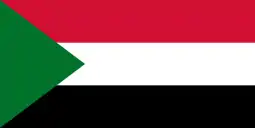 Sudan[94]
Sudan[94]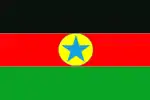 Sudan Revolutionary Front[92]
Sudan Revolutionary Front[92] Syria[94]
Syria[94] Tahrir al-Sham[94]
Tahrir al-Sham[94] Tajikistan[94]
Tajikistan[94] Taliban[93]
Taliban[93] Tanzania[94]
Tanzania[94] Tunisia[8]
Tunisia[8] Turkmenistan[94]
Turkmenistan[94] Uganda[94]
Uganda[94] Ukraine[94]
Ukraine[94] United Arab Emirates[102]
United Arab Emirates[102] United Wa State Army[92]
United Wa State Army[92] Uzbekistan[8]
Uzbekistan[8] Vietnam[94]
Vietnam[94]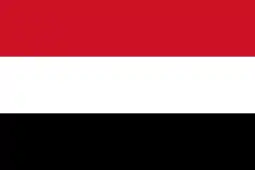 Yemen[95]
Yemen[95] Zambia[94]
Zambia[94] Zimbabwe[94]
Zimbabwe[94]
- Many other countries, along with numerous terrorist and paramilitary groups.
Former operators
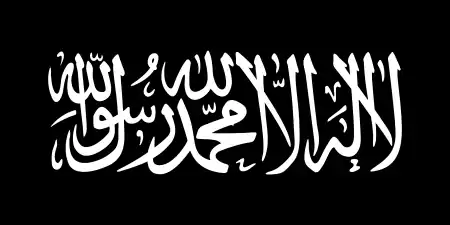 Afghan Mujahideen
Afghan Mujahideen African National Congress[95]
African National Congress[95] Ahlu Sunna Waljama'a[93]
Ahlu Sunna Waljama'a[93] Ansar al-Islam[105]
Ansar al-Islam[105].svg.png.webp) Ansar al-Sharia (Libya)[106]
Ansar al-Sharia (Libya)[106] Argentina[68]
Argentina[68]- Armed Forces Revolutionary Council[93]
- Army of Republika Srpska
- Army of the Republic of Serb Krajina
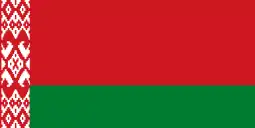 Belarus: Phased out from active service. 29 disposed of.[107][108]
Belarus: Phased out from active service. 29 disposed of.[107][108]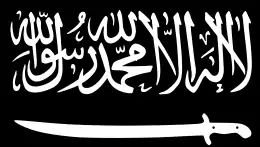 Caucasus Emirate[92]
Caucasus Emirate[92]- Chadian Union of Forces for Democracy and Development[92]
 Mali CNRDR[93]
Mali CNRDR[93] Contras[109]
Contras[109] Croatia[8]
Croatia[8] Cyprus[102]
Cyprus[102] Czechoslovakia[95]
Czechoslovakia[95] East Germany[95]
East Germany[95] ETA[93]
ETA[93] Farabundo Martí National Liberation Front (FMLN)[78]
Farabundo Martí National Liberation Front (FMLN)[78] FARC[92]
FARC[92] Finland (Strela-2M operated under designation 'ItO-78')[95]
Finland (Strela-2M operated under designation 'ItO-78')[95].svg.png.webp) Frelimo[50]
Frelimo[50] Germany
Germany Harkat ul-Ansar[93]
Harkat ul-Ansar[93] Hungary[95]
Hungary[95].svg.png.webp) Iraq[92]
Iraq[92].png.webp) Islamic Army in Iraq[38]
Islamic Army in Iraq[38] Islamic Courts Union[93]
Islamic Courts Union[93] Islamic State in Libya[110]
Islamic State in Libya[110]- Jaish al-Haramoun[111]
 Jamiat-e Islami[93]
Jamiat-e Islami[93] Jordan[8]
Jordan[8]- Jumbish-e-Mili[93]
 Kosovo Liberation Army[93]
Kosovo Liberation Army[93]- Kurdistan Democratic Party
 Lebanese Forces[112]
Lebanese Forces[112] Liberation Tigers of Tamil Eelam[93]
Liberation Tigers of Tamil Eelam[93]- Liberians United for Reconciliation and Democracy[93]
- Mujahideen Shura Council of Derna[113]
 National Congress for the Defense of the Congolese People[93]
National Congress for the Defense of the Congolese People[93] National Liberation Army[93]
National Liberation Army[93]- Niger Movement for Justice[93]
.svg.png.webp) North Vietnam[12]
North Vietnam[12] North Yemen[95]
North Yemen[95] PAIGC[49]
PAIGC[49] Palestinian Authority[93]
Palestinian Authority[93] Palestine Liberation Organization factions in Lebanon;[25] likely As-Sa'iqa[114]
Palestine Liberation Organization factions in Lebanon;[25] likely As-Sa'iqa[114]- Patriotic Movement of Côte d'Ivoire[93]
 People's Armed Forces of Liberation of Angola[115]
People's Armed Forces of Liberation of Angola[115] People's Liberation Army[20]
People's Liberation Army[20].svg.png.webp) People's Movement for the Liberation of Angola[116]
People's Movement for the Liberation of Angola[116] Popular Front for the Liberation of the Occupied Arabian Gulf[117]
Popular Front for the Liberation of the Occupied Arabian Gulf[117]- Provisional Irish Republican Army[93]
 Revolutionary United Front[93]
Revolutionary United Front[93]- Salafist Group for Preaching and Combat[93]
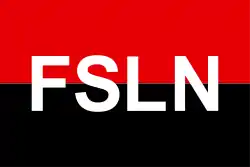 Sandinista National Liberation Front[70]
Sandinista National Liberation Front[70]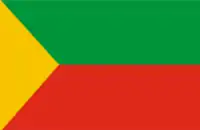 Shan State Army[92]
Shan State Army[92] Slovenia[8]
Slovenia[8]- Somali National Alliance[93]
- Somali Salvation Alliance[93]
 South Africa[102]
South Africa[102] South Yemen[95]
South Yemen[95] Soviet Union
Soviet Union.svg.png.webp) Sudan People’s Liberation Army[93] Incorporated into government.
Sudan People’s Liberation Army[93] Incorporated into government.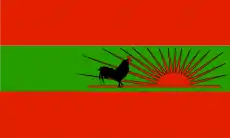 UNITA[52]
UNITA[52] Viet Cong[95]
Viet Cong[95] White mercenaries in the Congo[118]
White mercenaries in the Congo[118].svg.png.webp) Yugoslavia[95]
Yugoslavia[95] Zimbabwe People's Revolutionary Army[63]
Zimbabwe People's Revolutionary Army[63]
- Along with countless other countries, rebel groups, terrorists, and individuals.
See also
- List of Russian weaponry
References
- https://www.armyrecognition.com/russia_russian_army_light_heavy_weapons_uk/sa-7_grail_9k32_strela-2_portable_air_defense_missile_system_manpads_technical_data_sheet_pictures.html
- Efrat, Moshe (1983). "The Economics of Soviet Arms Transfers to the Third World. A Case Study: Egypt". Soviet Studies. 35 (4): 437–456. ISSN 0038-5859.
- "Переносной зенитно-ракетный комплекс 9К32М "Стрела-2М"". New-factoria.ru. Archived from the original on 2008-10-11. Retrieved 2013-08-24.
- "Зенитная управляемая ракета 9М32М | Ракетная техника". New-factoria.ru. 2010-11-14. Archived from the original on 2009-04-14. Retrieved 2013-08-24.
- https://www.armyrecognition.com/russia_russian_army_light_heavy_weapons_uk/sa-7_grail_9k32_strela-2_portable_air_defense_missile_system_manpads_technical_data_sheet_pictures.html
- James C. O'Halloran. Jane's Land Based Air Defence 2005–2006 (10th ed.). Jane's Information Group, London.
- https://medium.com/war-is-boring/meet-the-missiles-that-started-the-manpads-craze-fae345aeaa83
- Dr. Michael Ashkenazi; Princess Mawuena Amuzu; Jan Grebe; Christof Kögler; Marc Kösling (February 2013). "MANPADS: A Terrorist Threat to Civilian Aviation?" (PDF). Bonn International Center of Conversion (BICC) - Internationales Konversionszentrum Bonn GmbH. Archived (PDF) from the original on 2018-08-21. Retrieved 2018-08-20.
- Twentieth Century Artillery (ISBN 1-84013-315-5), 2000, Ian Hogg, Chapter 6, p. 226.
- Lappi, Ahti: Ilmatorjunta Kylmässä Sodassa, 2003
- On arrows and needles: Russia's Strela and Igla portable killers. Journal of Electronic Defense, January, 2004. Michal Fiszer and Jerzy Gruszczynski
- ""Стрела-2" (9К32, SA-7, Grail), переносный зенитный ракетный комплекс — ОРУЖИЕ РОССИИ, Информационное агентство". Arms-expo.ru. Archived from the original on 2011-01-26. Retrieved 2013-08-24.
- War Machine, issue 64 (magazine), 1984, Orbis Publications, p. 1274.
- "SA-7 "Grail" (9K32 "Strela-2")". bellum.nu. 2007-03-07. Archived from the original on 2008-06-02. Retrieved 2013-08-24.
- Cullen & Foss 1992, p. 41
- Cullen & Foss 1992, p. 42
- "Archived copy" (PDF). Archived (PDF) from the original on 2017-01-23. Retrieved 2018-07-21.CS1 maint: archived copy as title (link)
- "Militants Down Egyptian Helicopter, Killing 5 Soldiers". Archived from the original on 1 February 2017. Retrieved 5 October 2014.
- "Libya's Chaos More a Threat to US Than Iraq Ever Was". The PJ Tatler. Archived from the original on 6 October 2014. Retrieved 5 October 2014.
- Tom Cooper & Eric L. Palmer (26 September 2003). "Disaster in Lebanon: US and French Operations in 1983". Acig.org. Archived from the original on 7 October 2013. Retrieved 2013-08-24.
- Micah Zenko (13 February 2012). "When America Attacked Syria". Politics, Power, and Preventive Action. Council on Foreign Relations. Archived from the original on 7 October 2014. Retrieved 5 October 2014.
- "2005". Ejection-history.org.uk. Archived from the original on 2013-09-21. Retrieved 2013-08-24.
- Chivers, C.J. (24 July 2013). "The Risky Missile Systems That Syria's Rebels Believe They Need". The New York Times. Archived from the original on 22 February 2014. Retrieved 22 November 2014.
- Chivers, C. J.; Schmitt, Eric; Mazzetti, Mark (21 June 2013). "In Turnabout, Syria Rebels Get Libyan Weapons". The New York Times. Archived from the original on 24 July 2016. Retrieved 4 February 2017.
- See US State Department Cable Beirut 7015, Jun. 20, 1974
- Ken Guest, Lebanon, in Flashpoint! At the Front Line of Today's Wars, Arms and Armour Press, London 1994, p. 106. ISBN 1-85409-247-2 This source reports on the loss of an American-made F-16, though the plane was actually an Israeli-made Kfir.
- https://www.jta.org/1983/11/21/archive/israeli-plane-shot-down-by-surface-to-air-missiles-over-lebanon
- https://www.washingtonpost.com/archive/politics/1983/11/21/israelis-bomb-lebanese-sites-lose-one-plane/72852c73-52a8-4913-9901-3278bfdb9a7c/
- https://www.nytimes.com/1983/11/21/world/israeli-jets-bomb-palestinian-bases-in-lebanon-hills.html
- Samer Kassis, 30 Years of Military Vehicles in Lebanon, Beirut: Elite Group, 2003, p. 36. ISBN 9953-0-0705-5
- Nicolas Blanford (2011) Warriors of God: Inside Hezbollah's Thirty-Year Struggle Against Israel. New York: Random House.
- "Terrorists known to possess SAMs". CNN. 2002-11-28. Archived from the original on 2011-03-22. Retrieved 2010-05-24.
- "Spirit 03 and the Battle for Khafji". Archived from the original on October 25, 2008. Retrieved 5 October 2014.
- "Netzwerk Friedenskooperative – Themen – Türkei/Kurdistan-Invasion – turkhg52". Friedenskooperative.de. 1997-06-06. Archived from the original on 2013-05-14. Retrieved 2013-08-24.
- "ASN Aircraft accident 04-JUN-1997 Aérospatiale AS 532UL Cougar 140". Aviation-safety.net. Archived from the original on 2014-05-17. Retrieved 2013-08-24.
- "Sabah Politika Haber". Arsiv.sabah.com.tr. Archived from the original on 2011-10-23. Retrieved 2013-08-24.
- "Rebel Missiles Could End Up Being a Nightmare for Turkey – Al-Monitor: the Pulse of the Middle East". Al-Monitor. Archived from the original on 2013-05-17. Retrieved 2013-08-24.
- John F. Burns. "Video Appears to Show Insurgents Kill a Downed Pilot". The New York Times. Archived from the original on 2013-05-17. Retrieved 2013-08-24.
- "Why are U.S. helicopters getting shot down in Iraq? | FP Passport". Blog.foreignpolicy.com. 2007-02-19. Archived from the original on 2011-07-17. Retrieved 2013-08-24.
- "TRACES OF TERROR: THE DRAGNET; Sudanese Says He Fired Missile at U.S. Warplane". New York Times. 14 June 2002. Archived from the original on 7 November 2012. Retrieved 19 May 2011.
- Harel, Amos (2012-10-16). "For first time, Palestinians in Gaza fire missile at IAF helicopter Israel News Broadcast". Haaretz. Archived from the original on 2013-08-15. Retrieved 2013-08-24.
- "Small Arms, Big Problems – By Damien Spleeters". Foreign Policy. 2012-11-19. Archived from the original on 2013-06-09. Retrieved 2013-08-24.
- Desk, iHLS News (4 April 2016). "Al-Qaeda Brought Down Jet With Surface-to-Air Missile – iHLS Israel Homeland Security". Archived from the original on 12 March 2017. Retrieved 12 March 2017.
- "YouTube". youtube.com. Archived from the original on 2017-04-06. Retrieved 2017-03-17.
- Vietnam Air Losses, Christopher Hobson, 2002
- https://www.globalsecurity.org/military/world/vietnam/rvn-vnaf-equipment-data.htm
- "Roads of terror", ep. 1 Planete documentary film
- Coghlan, Tom (2007-07-28). "Taliban in first heat-seeking missile attack". Telegraph. Archived from the original on 2014-03-15. Retrieved 2013-08-24.
- Angola: Claims & Reality about SAAF Losses Archived 2011-10-26 at the Wayback Machine Retrieved 4 October 2011.
- Angola since 1961 Archived 2011-10-26 at the Wayback Machine Retrieved 4 October 2011.
- Criminal Occurrence description Archived 2016-01-19 at the Wayback Machine Retrieved 4 October 2011.
- Criminal Occurrence description Archived 2016-01-21 at the Wayback Machine Retrieved 4 October 2011.
- Man-Portable Air Defence Systems Archived 2011-09-27 at the Wayback Machine Retrieved 4 October 2011.
- Criminal Occurrence description Archived 2013-10-29 at the Wayback Machine Retrieved 4 October 2011.
- Criminal Occurrence description Archived 2015-07-12 at the Wayback Machine Retrieved 4 October 2011.
- Morocco, Mauritania & West Sahara since 1972 Archived 2012-07-29 at Archive.today Retrieved 4 October 2011.
- Western Sahara war 1975–1991 Archived 2011-10-04 at the Wayback Machine Retrieved 4 October 2011.
- Criminal Occurrence description Archived 2012-10-24 at the Wayback Machine Retrieved 4 October 2011.
- Criminal Occurrence description Archived 2016-02-03 at the Wayback Machine Retrieved 4 October 2011.
- Criminal Occurrence description Archived 2016-03-03 at the Wayback Machine Retrieved 4 October 2011.
- Anthony Trethowan (2008). Delta Scout: Ground Coverage operator (2008 ed.). 30deg South Publishers. p. 184. ISBN 978-1-920143-21-3.
- Criminal Occurrence description Archived 2011-06-06 at the Wayback Machine Retrieved 4 October 2011.
- Criminal Occurrence description Archived 2011-06-06 at the Wayback Machine Retrieved 4 October 2011.
- "Proliferation of MANPADS and the threat to civil aviation". Archived from the original on March 1, 2008. Retrieved 5 October 2014.
- Bolkcom; Elias; Feickert. "MANPADs Threat to Commercial Aviation" (PDF). Congressional Research Service. Archived from the original (PDF) on 2012-10-23. Retrieved 2013-08-24.
- War Machine, Italian version printed by De Agostini, Novara, 1983, p.155
- "The New Kremlin Bridgehead in Latin America by Andre Garcia". Traditioninaction.org. Archived from the original on 2013-08-30. Retrieved 2013-08-24.
- "Nicaragua - Авиация в локальных конфликтах - www.skywar.ru". Archived from the original on 28 February 2014. Retrieved 5 October 2014.
- "Nicaragua Reports Shooting Down Rebel DC-3 Registered in Oklahoma". NewsOK.com. Archived from the original on 6 October 2014. Retrieved 5 October 2014.
- "Daily News – Google News Archive Search". Archived from the original on 12 March 2016. Retrieved 5 October 2014.
- "Accident description". Aviation Safety Network. Archived from the original on 2 November 2012. Retrieved 17 July 2010.
- "Nicaragua says it downed a rebel supply plane". Archived from the original on 2016-03-06. Retrieved 2017-02-04.
- Omang, Joanne, and Wilson, George C., "Questions About Plane's Origins Grow", Washington Post, Washington, D.C., Thursday, October 9, 1986, pages A-1, A-32
- "Intrusions, Overflights, Shootdowns and Defections During the Cold War and Thereafter". Archived from the original on 14 May 2013. Retrieved 5 October 2014.
- "ASN Aircraft accident Fairchild C-123K Provider HPF821 San Carlos". 5 October 1986. Archived from the original on 6 October 2014. Retrieved 5 October 2014.
- Cooper, Tom. "El Salvador, 1980–1992". ACIG.org. Archived from the original on 16 January 2014. Retrieved 30 January 2013.
- "Blog de las Fuerzas de Defensa de la República Argentina: Conflictos americanos: El factor aéreo en El Salvador, 1980–1992 (2/2)". Fdra.blogspot.com. Archived from the original on 2014-01-16. Retrieved 2013-08-24.
- "Misiles tierra-aire SA-7 en posesión de las FARC – Analisis 24". 7 April 2013. Archived from the original on 7 April 2013.
- "Misiles Antiaéreos en Poder de las FARC. MANPAD SA-7 Strela". YouTube. 2012-12-09. Archived from the original on 2014-09-20. Retrieved 2013-08-24.
- "Incautado Misil Antiaéreo SA-7 "Grail" a las FARC, en el Departamento del Cauca ~ WebInfomil". Webinfomil.com. Archived from the original on 2013-06-07. Retrieved 2013-08-24.
- "Revista dice que misiles chinos eran efectivos". Archived from the original on 6 October 2014. Retrieved 5 October 2014.
- "Ejercito Ecuatoriano incauta misil antiaéreo destinado a las FARC ~ Webinfomil". Archived from the original on 6 October 2014. Retrieved 5 October 2014.
- "Militares ecuatorianos descubren un misil cerca de la frontera con Colombia". YouTube. Archived from the original on 24 June 2014. Retrieved 5 October 2014.
- "CIS region - Авиация в локальных конфликтах - www.skywar.ru". skywar.ru. Archived from the original on 2018-04-19. Retrieved 2017-10-23.
- Jackson, Brian A., et al. Aptitude for Destruction, Volume 2: Case Studies of Organizational Learning in Five Terrorist Groups, Volume 2 Rand Corporation, May 5, 2005, pg. 110.
- "ETA quiso atentar con misiles contra Aznar en 2001". Archived from the original on 18 February 2014. Retrieved 5 October 2014.
- Govan, Fiona (2010-01-18). "Spanish PM 'saved' by faulty IRA missile". Telegraph. Archived from the original on 2013-10-04. Retrieved 2013-08-24.
- "ÇáäŮÇă ÇáŐÇŃćÎě Úíä ŐŢŃ". Aoi.com.eg. Archived from the original on 2014-02-16. Retrieved 2013-08-24.
- "Number of Gaza terror groups possess Strela 2 MANPADS". FDD's Long War Journal. 25 September 2013. Archived from the original on 19 July 2018. Retrieved 19 July 2018.
- "Armed Actor Research Notes: Armed Groups' Holding of Guided Light Weapons. Number 31, June 2013" (PDF). Small Arms Survey. Archived (PDF) from the original on 2016-03-13. Retrieved 2018-07-02.
- "Guided light weapons reportedly held by non-state armed groups 1998-2013" (PDF). Small Arms Survey. March 2013. Archived (PDF) from the original on 2014-08-18. Retrieved 2018-06-28.
- International Institute for Strategic Studies (IISS) (14 February 2018). "The Military Balance 2018". The Military Balance. 118.
- "Trade Register". Stockholm International Peace Research Institute. Archived from the original on 2010-04-14. Retrieved 2018-07-20.
- Small Arms Survey (2015). "Waning Cohesion: The Rise and Fall of the FDLR–FOCA" (PDF). Small Arms Survey 2015: weapons and the world (PDF). Cambridge University Press. p. 203. Archived (PDF) from the original on 2018-01-28. Retrieved 2018-08-29.
- "Defense & Security Intelligence & Analysis: IHS Jane's | IHS". Janes.com. Retrieved 2013-08-24.
- "Oryx on Twitter". Archived from the original on 2017-03-15. Retrieved 2018-07-19.
- "MENASTREAM on Twitter".
- "MENASTREAM on Twitter".
- "Turan Oguz on Twitter".
- Thomas W. Zarzecki, (2002). Arms Diffusion: The Spread of Military Innovations in the International System. Routledge ISBN 0415935148
- "Mongolian Army".
- "Iraq: Turning a blind eye: The arming of the Popular Mobilization Units" (PDF). Amnesty International. 5 January 2017. Archived (PDF) from the original on 13 March 2017. Retrieved 28 June 2018.
- "Syria war: Rebel group supplied with anti-air missiles". Middle East Eye. Archived from the original on 2018-07-20. Retrieved 2018-07-20.
- "Alex Mello on Twitter".
- "Белоруссия полностью утилизировала ПЗРК "Стрела-2М" — ОРУЖИЕ РОССИИ, Информационное агентство". Arms-expo.ru. Archived from the original on 2014-04-13. Retrieved 2013-08-24.
- "Belarus scraps obsolete portable air defense systems | World | RIA Novosti". En.rian.ru. Archived from the original on 2013-05-17. Retrieved 2013-08-24.
- "Archived copy" (PDF). Archived (PDF) from the original on 2017-01-23. Retrieved 2018-07-21.CS1 maint: archived copy as title (link)
- "Oded Berkowitz on Twitter".
- "Sami on Twitter".
- Samer Kassis, 30 Years of Military Vehicles in Lebanon, Beirut: Elite Group, 2003. ISBN 9953-0-0705-5 p. 36.
- "MENASTREAM on Twitter".
- "Archived copy" (PDF). Archived (PDF) from the original on 2017-01-23. Retrieved 2018-07-21.CS1 maint: archived copy as title (link)
- Jaster, Robert Scott (1997). The Defence of White Power: South African Foreign Policy under Pressure. Basingstoke: Palgrave-Macmillan. pp. 66–68, 93–103. ISBN 978-0333454558.
- Geraint Hughes, My Enemy's Enemy: Proxy Warfare in International Politics. Sussex Academic Press, 2014. p. 73.
- Jeapes, Tony (1980). SAS Operation Oman. London: William Kimber. p. 227. ISBN 978-0-7183-0018-0.
- S. Boyne, "The White Legion: Mercenaries in Zaire", Jane's Intelligence Review, London. June 1997, p. 279.
- Cullen, Tony; Foss, Christopher F., eds. (1992). Jane's Land-Based Air Defence 1992–93 (5th ed.). Coulsdon, UK: Jane's Data Division. ISBN 0-7106-0979-5.
External links
| Wikimedia Commons has media related to Strela-2. |